
Today, let’s talk about the history , medicinal uses of the walnut tree and, of course dyeing.
From a dyer’s point of view, the walnut tree is fantastic!
It’s very rich in tannins and all parts of the tree can be used to dye with. It’s also pretty sustainable. You can use fallen leaves, ask for cut branches when it’s time to prune them and gather the husks.
And it’s always fun to learn more more about the folklore and medicinal properties of a dye and how it’s been used for centuries!
Let’s tackle the history and folklore of the walnut tree!
The uses of the walnut tree through history
Which walnut tree are we talking about?
First, let’s clarify what I mean by walnut tree.
From the encyclopedia Britannica, we learn that the walnut tree represents 20 species from the Juglandaceae family. The ones you will encounter the most are the Black Walnut (Juglans nigra) from North America and the English Walnut (Juglans regia), originally from Iran.
Now that this is out of the way, let’s dive into the history of the walnut tree.
Romans used the walnuts tree for dyeing black fabric thanks to the tannin combined with iron salts. Walnuts were aleady a popular food item. Some were even found in the Temple of Isis at Pompeii after the Vesuvius’ eruption. Evidence of dyeing with the walnut tree were also found at Pompeii.
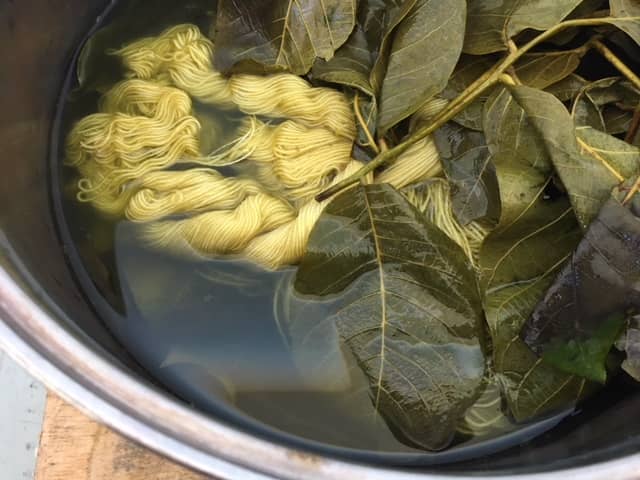
It’s no surprise that the Vikings used the walnut tree as a dyeing source as well, along other natural sources like lichen and woad. Walnut shells from the Juglans regia species were found in Viking settlements (Hedeby) and on burial sites (Oseberg).
In the Middle-Ages, the guilds in European countries structured the different steps in the dyeing process and it went as far as having a group dedicated to black dye in Germany.
Books about dyeing were already published in the mid-16th century and several recipes from Giovanventura Rosetti’s Plictho: Instructions in the Art of the Dyers which Teaches the Dyeing of Woolen Cloths, Linens, Cottons, and Silk by the Great Art as Well as by the Common list dyeing with the different parts of the walnut tree.
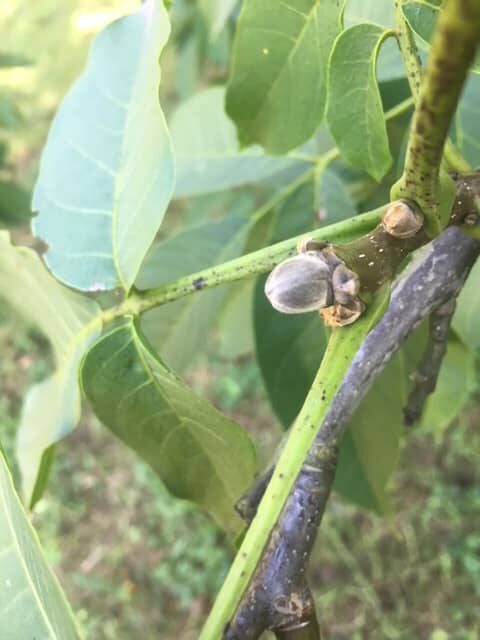
And outside of Europe?
Of course, India is famous for its dyeing tradition as well. We can trace back the use of walnut for dyeing to the Bhotiya community in Kumaeon while walnut trees have been grown extensively around Himalayan Uttarakhand. (Google Arts and Culture has really pretty pictures of the dye plants of Kumaeon on one of these virtual exhibits. )
Native Americans used the Juglans nigra species, the Black walnut. We can mention in particular the Meskwaki tribe of the Great Lakes, known to have created black dye with the bark. The colonists tried bringing with them the Juglans regia species but it kept dying. That’s when they turned to the Black walnut tree for dyeing their wool and fabrics. The walnut dye got especially popular during the Civil War since it was used to dye the uniforms of the Confederate soldiers.
The dye from the walnut tree is still popular today thanks to its high level in tannins. Research has showed that it’s highly efficient against moth, making it an invaluable environmental-friendly dye.
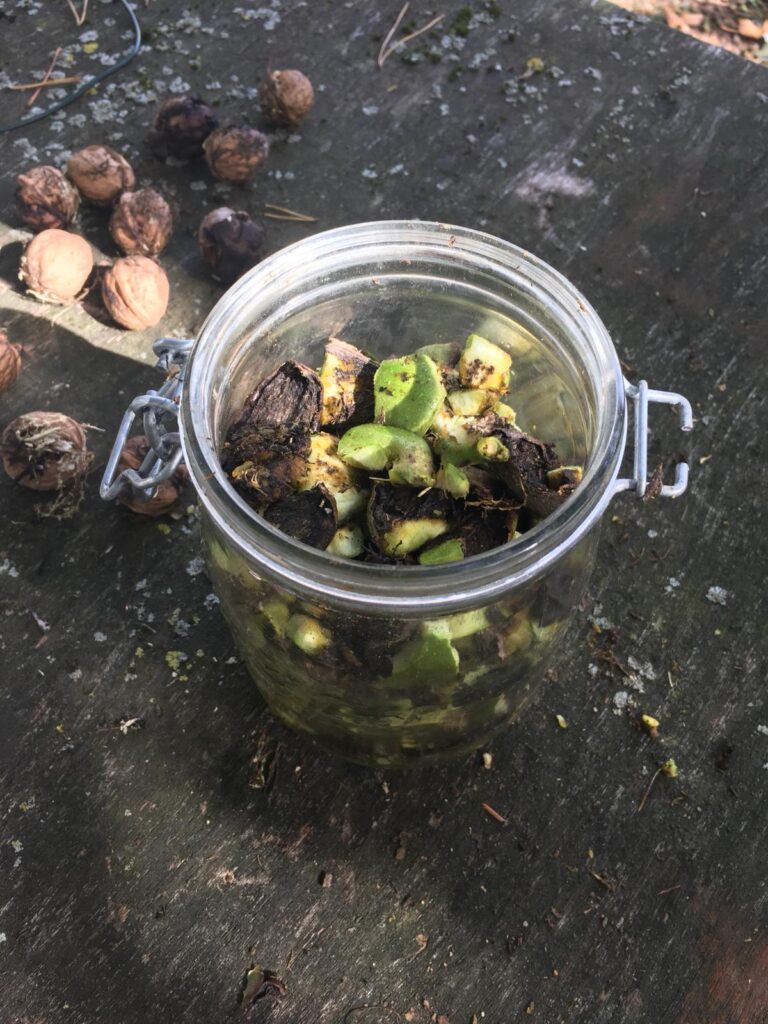
Legends and folklore around the walnut tree
Let's sprinkle some science on top of the folklore!
Legends and folklore are one of our favourite things when researching about dye plants and the walnut tree doesn’t disappoint!
We can trace stories of the tree supposedly bringing illness to plants, animals and humans alike from very early on. Pliny the Elder wrote that the shadow of the walnut was poisonous to all plants withing its compass.
And indeed, folktales in several European countries warn against sleeping under the shadow of the tree. Like most cautionary tales, there is a reason behind the warning. In this case, it’s due to the walnut tree producing the hydrojuglone chemical, which once oxidized produces the toxic chemical juglone. Since the roots and the hulls are highly concentrated in juglone, the canopy of the tree is where the plant toxicity is the most concentrated. Don’t worry, we now know that the juglone is not toxic to humans. It affects only certain families of plants like eggplants, tomatoes and peppers.
Now let’s go back to our legends with this scientific fact in mind.
We can find mentions of the walnut tree in several stories like Aesop’s fables and Native Americans oral traditions. One Native Americans legend tells the tale of the spirit of the Walnut Cracker. The Walnut Cracker would crack nuts, even after his death, scaring people so much in the process that their illnesses would disappear.
Yeah, witches!
One cannot mention folklore without a reference to witches. In the walnut tree’s case, if a woman was accused of being a witch and a walnut fell into her lap, she wouldn’t be able to get up. Ah the joys of the patriarchy! (I suspect a strong correlation between the modern slang for nut and this story where it’s basically about physical power and domination.).
Italy seems to have its fair share of walnut trees stories tied to witches, between tales of witches dancing at night under walnut trees and the tree of Benevento. This tree was, in the 17th century, supposed to be a place where witches gathered. The tree was removed but another grew in its place to be reclaimed by the witches (which I completely agree with. 1-let’s not unroot trees and 2- leave the wise ladies their place of meeting!).
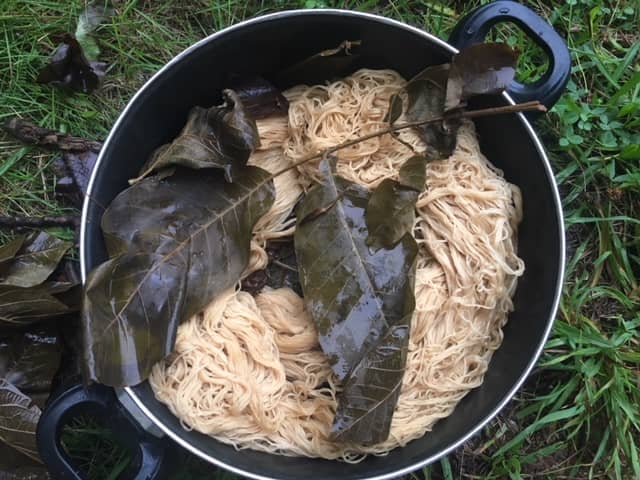
To finish, we can mention the Bulgarian tales around the walnut tree because they have plenty! Their own take about not sleeping under walnut trees is -of course- linked to women harassing these poor dudes. This time, witches are replaced by nymphs (samodiva) and female demons (yuda), giving us again the dichotomy between young maidens and old women (insert a strong eye roll here).
Another predominant tale mentions the act of planting a walnut tree as bringing death to the one doing it. We find again this correlation with the shadow of the walnut tree bringing illness. The Bulgarian tale adds to this story a trick. It involves a red sash used to determine the width of the future tree trunk, ensuring a delay long enough to allow a long life to the one who planted the walnut tree.
The walnut tree: not just for dyeing or eating but also for healing
Medicinal and herbal benefits
Juglans comes from Jovis glans, which can be translated as Jupiter’s nut. (Surprising no one because, well it’s Jupiter/Zeus after all). Anyway, the walnut was associated with fertility and a tradition was to throw walnuts during weddings to favorise pregnancy. The shape of the walnut itself looks a lot like a brain. This made people think it was probably excellent for the brain.
Once again, they were not wrong.
Walnuts have a lot of health benefits, already recognized since the Middle-Ages. People used all parts of the tree in the treatments of ailments like laxatives and vermifuges, as a styptic to stop bleeding but also against diarrhea and inflamed gums. Walnuts, in relation with pregnancy, were used against morning sickness and to strengthen health.
In the 90s, American studies showed that walnuts could lower cholesterol and diminish heart damage following a heart attack.
The oil itself is highly valued in the kitchen for being rich in antioxydants while the raw walnut itself is rich in proteins and omega3 but also minerals and vitamins. It’s crazy to think all that can be done with this tree.
I lied, it’s always about dyeing. Let’s talk hair dye!
As you’ve probably gathered if you have read some of our other blog posts and our about us, we like to talk about dyeing and knitting but also history and science. Hence why I thought it would be fun to branch out a little and touch briefly another form of dyeing. I mean hair dye is fun, right? In our blog post about dye recipes for beginners, I mentioned henna as an easy dye powder since a lot of us have used it to dye hair. Dyeing with the walnuts tree isn’t the first hair dye that come to mind, true but it’s pretty popular too. It can actually be used with henna to enhance a deep shade of brown.
Of course, like with any natural component, be careful because some people can develop allergies to the dye. And don’t forget to use gloves and an old towel! Walnuts dye stains heavily and can be a pain to scrub off.
Since hair dye isn’t our area of expertise, I prefer linking to a really easy recipe to make your own hair dye with walnut shells powder.
History, medicinal uses, it’s all good but how do you dye with the walnut tree?
A recipe to dye with walnut leaves
Now that we have talked about the history, legends, medicinal uses and health benefits of the walnut tree (with a small detour with hair dye), it’s time for a fun and easy walnut tree dyeing recipe!
I chose a recipe with walnut leaves to give you something a little bit different. When you think walnut dye, it usually means the husks for a deep brown but the leaves can give a wonderful golden color!
I first came across it thanks to a post on the Instagram account of Hey Mama Wolf where Jule shared her tip for a gold recipe. The key is to wait to gather your leaves between September and October when the leaves are turning a pretty yellow.
And when I tried it myself, I was so excited to see this rich bronze gold coming out of my dye bath.
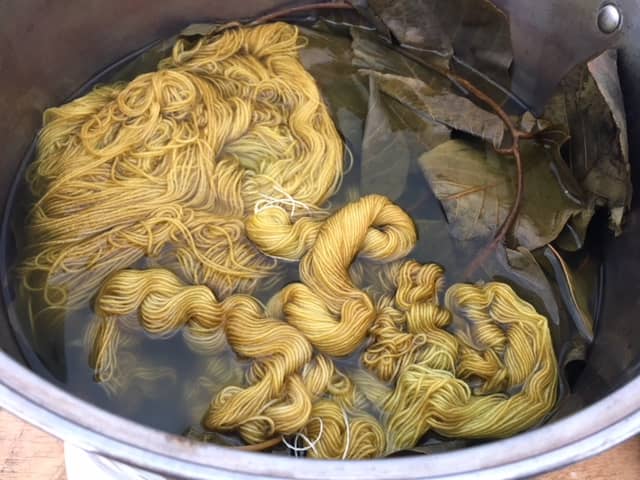
For realising a natural dyed project with walnut leaves, you will need:
Roughly 100g of walnut leaves. The idea is to get the same weight for the dyestuff and the items to dye. With leaves, since we are picking them from the ground or when the tree is pruned, I try to add as much as my pot can hold.
A pot large enough for water, walnut leaves and your wool. Keep this pot for dyeing purposes only, especially if you choose to mordant your fibers and don’t use your dyeing material for cooking.
A sieve but it’s really optional with leaves. I prefer to cover my fibres with the leaves and just wrap them around the fibres as much as possible.
Process for dyeing with walnut tree leaves
- Remove your fibers from their mordanted bath, gently remove the excess of water (if you don’t know how to mordant, follow the steps on our post about easy recipes to become a natural dyer.)
- Fill a big pot with water then add your walnut tree leaves.
- Heat up the water but don’t let it reach the boiling point.
- Let the pot of water and walnut leaves simmer for 1 hour.
- Turn the heat off and let it cool down a bit. It’ll give you richer and deeper colors if you leave it the whole night or at least several hours before straining your dye bath.
- Now, it’s time to strain your dye bath. Use your sieve or your hands (with gloves) to strain your walnut tree leaves.
- Now we have a proper dye bath ready to turn your fibers into true gold (just kidding, don’t come all Rumpelstiltskin on me, you won’t get my cats!).
- Remove your fibers from their mordanted bath, gently remove the excess of water and let them soak all the color up by immersing them in the dye bath.
- Heat up the pot slowly again so it can simmer for about 1 hour.
- Let it cool down.
- Once again it’s better to leaver your fibers several hours or a whole night in the dye bath. This way, the color will only get deeper.
- Once it’s cool down, rinse the fibers in cold water, let it dry and brag about your hard work!
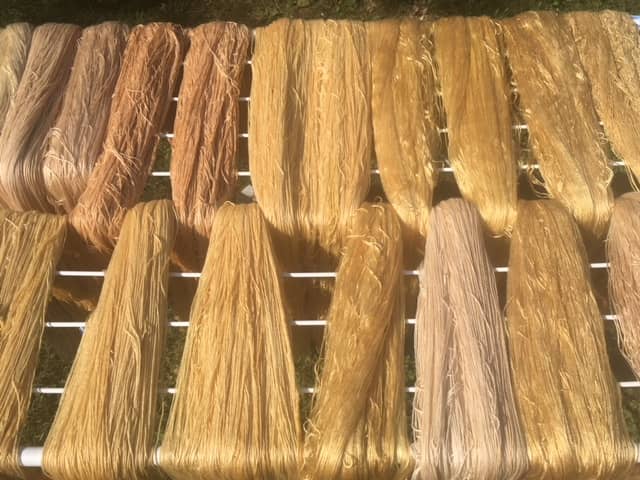
How to dye with the other parts of the walnut tree
As I mentioned above, dyeing with walnut husks is popular and for good reasons! It gives a great colour if you want beautiful browns.
It’s not just used for dyeing fabric either! The husks also add a glossy brown finish to furniture.
I couldn’t dye with walnut husks this year since I didn’t stock any from the previous year. And with the frost ruining so many cultures last spring in France, there wasn’t any walnuts on the walnut tree where I gather my dyestuff.
If you want to dye with walnut husks, then you will need to use the outer husks once it has fallen on the ground. It’s better to leave the husks at least one night, and longer if you can, in your dye bath. This way, you can be sure to obtain rich and darker browns. I sometimes add some cut branches or bark if I found them on the ground, to deepen the color.
You can play with mordants to get a whole range of browns and even black with iron. Just explore and have fun!
We hope you enjoyed learning all the history and the use behind this tree. That’s why natural dyeing is so interesting, it’s not just a color you obtain but a whole story!
If you’d like your own herbal memento of the walnut tree, we got a treat for you!
We created special embroidery kits! It contains a mini zine about the walnut tree, a fall illustration, a skein of vegan thread dyed with walnut leaves and of course, a pattern representing the different parts of this magical tree.
It’s all completely beginner friendly so you can celebrate autumn with us!
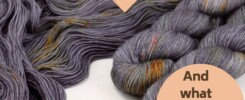

Very informative and love the hilarious narrative vibe